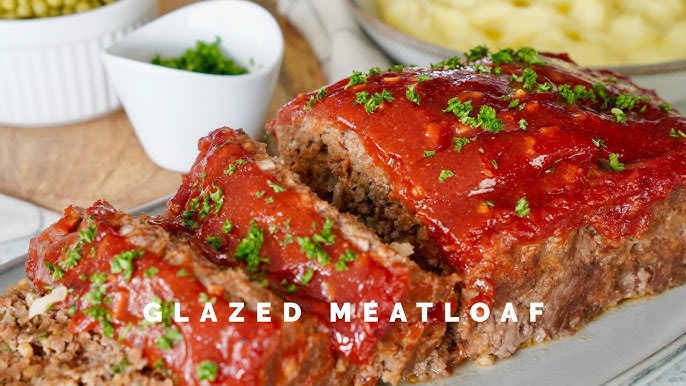Meatloaf Sauce Recipe: Let’s be honest—meatloaf without the sauce is like a burger without a bun. The sauce brings it all together. It’s where sweet, tangy, and savory flavors meet and mingle, transforming a good dish into a great one. Meatloaf sauce not only adds taste but also texture and moisture, sealing in flavor and giving that beautiful, caramelized glaze on top.
Why does it matter so much? Because meatloaf is dense and hearty. Without the right sauce, it can taste dry or one-dimensional. A great sauce cuts through that richness and keeps every bite exciting. Think of it like a duet—meat and sauce singing in perfect harmony.
Most traditional meatloaf sauces start with ketchup, but the secret to greatness lies in the balance—sweetness from brown sugar, tang from vinegar, and a kick from mustard or spices. With just a few pantry staples and a few easy steps, you’ll be ready to create a mouthwatering sauce that’ll have everyone asking for seconds.
Essential Ingredients for Meatloaf Sauce
This sauce is as simple as it is satisfying. It’s built on ingredients you probably already have in your kitchen, which makes it both easy and budget-friendly. And once you master the base, you can tweak it to match your flavor preferences.
Let’s break it down:
Core Ingredients
These are the non-negotiables, the trio that gives the sauce its classic taste and consistency:
- Ketchup: The backbone of the sauce. It adds tomato richness and just the right amount of sweetness.
- Brown Sugar: This gives that caramelized sweetness and helps thicken the sauce as it cooks.
- Vinegar: A splash of apple cider vinegar or white vinegar cuts through the sweetness and balances the flavor with a tangy zing.
Each plays a vital role: ketchup gives body, sugar adds depth, and vinegar brightens the taste.
Flavor Boosters
Here’s where you can make the sauce your own. Depending on your taste buds, you can add:
- Worcestershire Sauce: Adds umami depth and a savory punch.
- Yellow Mustard or Dijon: Introduces a bit of sharpness and heat.
- Garlic Powder or Onion Powder: For a more complex flavor base.
- Smoked Paprika or Cayenne Pepper: A little heat goes a long way.
These extras turn a simple sauce into something unforgettable. They’re the flavor ninjas—subtle but powerful.
Equipment You’ll Need
You don’t need fancy kitchen gear to whip up meatloaf sauce. In fact, it’s so easy, you can mix it right in a bowl or cook it on the stovetop if you want extra depth.
Here’s what you’ll need:
- Mixing Bowl: For combining the ingredients.
- Whisk or Spoon: A whisk helps blend the sugar better into the ketchup.
- Measuring Cups and Spoons: Precision matters—too much vinegar can overpower the whole thing.
- Small Saucepan (Optional): If you want to simmer the sauce and deepen the flavor before applying it to the meatloaf.
Optional but helpful:
- Rubber Spatula: To scrape every bit of sauce from the bowl or pan.
- Basting Brush: To evenly coat the meatloaf before baking.
That’s it! Simple tools for a stunning result.
Preparing the Meatloaf Sauce – Step-by-Step Instructions
This is where the magic happens. You’ll be combining the ingredients, simmering (if you want), and fine-tuning the flavor until it’s just right. It’s all about layering in that sweet, tangy goodness.
Step 1: Gather Ingredients
Here’s your shopping list for the base recipe:
- 1 cup ketchup
- 2 tablespoons brown sugar (light or dark)
- 1 tablespoon apple cider vinegar
- 1 teaspoon Worcestershire sauce (optional)
- 1 teaspoon yellow mustard (optional)
- ½ teaspoon garlic powder
- Pinch of black pepper
Gathering your ingredients beforehand makes the process smoother and quicker. If your brown sugar is hard, microwave it for a few seconds to soften it. Also, always level off your measurements—too much vinegar or sugar can throw off the balance.
Step 2: Mix the Ingredients Thoroughly
Add all the ingredients into a mixing bowl. Start with ketchup as the base, then add the brown sugar, vinegar, and any optional flavor boosters.
Use a whisk to mix everything together until it’s smooth. You want to ensure the brown sugar dissolves completely and you don’t have any lumps. It should look glossy and well-blended.
At this stage, you can taste it with a spoon. Want more tang? Add a splash of vinegar. More sweetness? Another pinch of sugar. Customize it till it fits your flavor profile.
Step 3: Simmer the Sauce
This step is optional but highly recommended if you want a richer, thicker sauce. Transfer your mixed sauce into a small saucepan and place it over medium-low heat. Stir occasionally as it begins to warm up.
Simmering does a few magical things:
- Deepens the flavor: Heat helps the ingredients meld together.
- Thickens the consistency: Especially important if you want a glaze that sticks to your meatloaf instead of running off.
- Reduces acidity: Vinegar and ketchup both have sharp notes. Gentle heat smooths that out.
Let the sauce simmer for 5 to 10 minutes. Stir frequently to prevent sticking or burning. You’ll notice it gets darker and shinier—that’s your cue that it’s ready. Once done, remove it from the heat and let it cool slightly before using it.
If you’re in a rush, you can skip the simmering and go straight to applying the sauce, but trust me, a little patience here goes a long way.
Step 4: Taste and Adjust Seasoning
This is your chance to make it perfect. Give the sauce a taste. What’s missing? Here’s how to tweak it:
- Too tangy? Add a bit more brown sugar or a tiny splash of maple syrup.
- Too sweet? Add an extra dash of vinegar or mustard.
- Flat taste? A sprinkle of salt, a shake of pepper, or a splash of Worcestershire sauce can wake it up.
- Want heat? A dash of cayenne or hot sauce does wonders.
The beauty of homemade sauce is you control the outcome. Trust your taste buds. Dip a spoon, adjust, and repeat until you hit that sweet spot of tangy-sweet perfection.
Applying the Sauce to Your Meatloaf
Now that you’ve nailed the sauce, it’s time to use it like a pro. When and how you apply the sauce makes a big difference in the final dish. You don’t want it to burn or dry out, and you definitely want that sticky, delicious glaze on top.
Here’s the best technique:
- After shaping the meatloaf but before baking: Apply a thick, even layer of sauce on top. Use a spoon or basting brush to spread it to the edges.
- Mid-bake application (optional): If your loaf is baking for an hour, consider applying half the sauce at the 30-minute mark and the rest during the last 10 minutes. This builds a layered, caramelized finish.
- Final coat after baking: For an extra saucy bite, reserve a few tablespoons of warm sauce and brush it on just before serving.
Whatever you do, make sure the sauce doesn’t drip down the sides and burn on the baking tray. Use parchment paper or foil to make cleanup easier.
This technique guarantees a glossy, mouthwatering topping that adds both flavor and presentation value.
Tips for the Best Meatloaf Sauce
Let’s level up your sauce game with a few insider tips. These little tricks can transform your everyday meatloaf sauce into a recipe worth bragging about.
1. Use dark brown sugar for deeper flavor
It contains more molasses than light brown sugar, giving your sauce a richer, almost caramel-like taste.
2. Add a splash of soy sauce
Just half a teaspoon can introduce umami depth without overpowering the classic taste.
3. Mix in a teaspoon of tomato paste
This thickens the sauce and boosts the tomato flavor—especially if your ketchup is on the thinner side.
4. Use Dijon mustard instead of yellow
Dijon gives a more sophisticated kick and blends smoother into the sauce.
5. Don’t skip the simmer
Even just 5 minutes of heating brings all the flavors together like magic. It’s the difference between good and great.
6. Make it ahead of time
Letting the sauce sit in the fridge for a few hours (or overnight) allows the flavors to develop more complexity.
A little experimentation, a little love, and you’ve got a sauce that steals the show every time.
Common Mistakes to Avoid
Even the simplest sauce can go sideways if you’re not careful. Let’s save you from some of the most common slip-ups.
1. Too much sugar
Yes, the sauce should be sweet—but not syrupy. Start with the recommended amount, then adjust to taste.
2. Skipping the tasting step
Don’t just mix and pour. Always taste your sauce before using it. Every ketchup brand and vinegar type is different.
3. Pouring the sauce all at once
Layer it during baking. One thick coating can slide off or burn instead of giving you that sticky glaze.
4. Not simmering long enough
If you’re heating your sauce, give it time to reduce and thicken. A runny sauce won’t stick to the meatloaf and may pool around it instead.
5. Using cold sauce on hot meatloaf
Warm up your sauce before applying it post-bake. Cold sauce can cool down the meat or mess with the texture.
Avoiding these little traps ensures your meatloaf sauce is always a winner.
Meatloaf Sauce Variations
One of the best things about homemade meatloaf sauce? You can easily customize it. Once you’ve got the base recipe down, the possibilities are endless. Whether you’re craving something spicy, smoky, or sweet, here are a few mouthwatering variations to spice up your next meatloaf night.
1. Sweet & Spicy Glaze
Want a little heat? Add 1 teaspoon of sriracha or hot sauce to the classic recipe. You can also mix in a pinch of red pepper flakes or a dash of cayenne. This version gives you that classic sweetness with a fiery kick—perfect for spice lovers.
2. Smoky BBQ-Style Sauce
Replace half the ketchup with your favorite BBQ sauce and add a dash of smoked paprika or liquid smoke. You’ll get a smoky depth that’s perfect for grilled or smoked-style meatloaf. Great for summer cookouts or if you just want that BBQ taste without firing up the grill.
3. Honey Mustard Glaze
Swap out brown sugar for 2 tablespoons of honey and mix in a tablespoon of Dijon or whole-grain mustard. This sweet and tangy version pairs beautifully with turkey or chicken meatloaf for a lighter, zippier flavor.
4. Maple-Balsamic Sauce
Trade brown sugar for real maple syrup and add a splash of balsamic vinegar in place of apple cider vinegar. This upscale twist brings a rich, gourmet flavor with a hint of earthiness—perfect for fancy family dinners.
5. Italian-Inspired Tomato Herb Sauce
Use tomato sauce instead of ketchup, add a teaspoon of Italian seasoning, a pinch of red pepper flakes, and finish with grated Parmesan cheese. This one feels more like a marinara-style glaze—great with beef and veal meatloaf combos.
Experimenting with different sauce variations is a fun way to keep meatloaf night fresh and exciting. Feel free to mix, match, and taste as you go!
Storing and Reheating the Sauce
So you’ve made a killer meatloaf sauce—what if you’ve got leftovers, or you want to prep ahead? No problem. Here’s how to keep it fresh and flavorful.
Refrigeration
Store any leftover sauce in an airtight container in the fridge. It’ll last up to 7 days. The flavors often deepen after a day or two, making it even tastier as leftovers.
Before using again, just reheat it gently in a small saucepan over low heat. If it’s too thick, add a splash of water or broth to loosen it up.
Freezing
Yes, you can freeze meatloaf sauce! Pour it into a freezer-safe container or zip-top bag. Label it with the date and freeze for up to 3 months. Thaw in the fridge overnight before reheating.
Meal Prep Tips
If you’re making meatloaf ahead of time, go ahead and make a double batch of sauce. Use half while baking and save the rest for reheating or serving on the side.
Always reheat the sauce separately if you want to keep that smooth, glaze-like texture. Microwaving directly on meatloaf can make the sauce uneven or gummy.
Keeping your sauce stored and reheated properly means you’re always just minutes away from the perfect meatloaf topping—even on your busiest weeknights.
FAQs about Meatloaf Sauce Recipe
1. What is the best sauce to put on meatloaf?
The best sauce for meatloaf is typically a rich, tomato-based glaze. Many prefer a combination of ketchup, brown sugar, and mustard, offering a perfect balance of sweetness and tang. However, feel free to experiment with BBQ sauce or a spicy tomato sauce for a kick!
2. Can I make meatloaf sauce without ketchup?
Absolutely! If you’re not a fan of ketchup or simply want to try something different, consider using tomato sauce or paste mixed with seasonings like garlic powder, onion powder, and herbs. Another great alternative is using a mix of Worcestershire sauce and brown sugar for a deeper flavor profile.
3. How do I get my meatloaf sauce to stick to the meatloaf?
To ensure your sauce adheres well to the meatloaf, apply a thin layer of the sauce on the meatloaf before baking it. This base layer will cook onto the surface. Add another generous layer about 15-20 minutes before your meatloaf is done baking to enhance the flavor and create a delicious, sticky glaze.
4. Is meatloaf sauce gluten-free?
This depends on the ingredients used in your sauce. Most ketchup and Worcestershire sauces are gluten-free, but it’s always best to check the labels if you’re catering to a gluten-free diet. For a guaranteed gluten-free option, make your sauce from scratch using gluten-free ingredients.
5. Can I prepare meatloaf sauce in advance?
Yes, preparing your meatloaf sauce in advance is a great time-saver. Simply mix your ingredients and store the sauce in an airtight container in the refrigerator for up to a week. When you’re ready to cook, your sauce will be ready to spread over your meatloaf.
6. How do I make my meatloaf sauce less sweet?
If you find the traditional meatloaf sauce too sweet, you can reduce the amount of sugar or honey in the recipe. Alternatively, adding a bit more vinegar or a splash of lemon juice can help balance out the sweetness.
Conclusion
There’s no denying it—a good meatloaf is comforting, nostalgic, and deeply satisfying. But a great meatloaf? That’s all about the sauce. Whether you stick to the classic sweet-and-tangy version or venture into smoky, spicy, or honey-glazed territory, the right sauce can transform your dish from simple to sensational.
And it doesn’t have to be complicated. With a few pantry staples, a little simmering, and some creativity, you can whip up a mouthwatering glaze that hits all the right notes—sweet, savory, tangy, and full of flavor. Make it ahead, tweak it to your taste, and never settle for bland meatloaf again.
So the next time you’re planning dinner, remember: the meat is just the beginning. The real magic is in the sauce.



